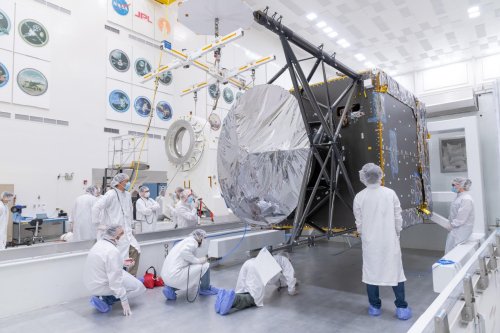
Out in the asteroid belt between Jupiter and Mars lurks a strange beast: An asteroid made almost completely of metal. Asteroid Psyche is 140 miles in diameter and is composed of primarily iron and nickel, and the richness of its metal has led to it being dubbed the “$10,000 quadrillion asteroid.” NASA is planning to visit the asteroid soon, but not for mining purposes — rather, the aim is to learn about the formation of planets in the early solar system.
For this mission, NASA’s Jet Propulsion Laboratory (JPL) has just taken delivery of the Psyche spacecraft, which will be launched on its mission to investigate the asteroid in 2022.
The chassis of the spacecraft, delivered by the company Maxar Technologies, has already been packed with most of the hardware required for the mission. Now, the engineers at JPL will perform the final assembly of the craft before moving onto testing and launch preparations.
“Seeing this big spacecraft chassis arrive at JPL from Maxar is among the most thrilling of the milestones we’ve experienced on what has already been a 10-year journey,” said Arizona State University’s Lindy Elkins-Tanton, principal investigator of the Psyche mission, in a statement. “Building this complex, precision piece of engineering during the year of COVID is absolutely a triumph of human determination and excellence.”
With the launch scheduled for August next year, the team is working on adding the flight computer, communications system, and the low-power distribution system to the craft. They will also be performing tests as they install the final hardware, along with adding the mission’s three science instruments which will arrive over the next few months.
“It’s exciting watching it all come together, and it’s the part of the project life cycle that I love the most,” said Psyche Project Manager Henry Stone of JPL. “But it’s a really intense phase as well. It’s intricate choreography, and if one activity runs into a problem, it can impact the whole process. Staying on schedule at this phase of the mission is absolutely critical.”
Following the launch next year, Psyche is set to fly past Mars twice for a gravity assist before arriving at the asteroid in 2026.
Editors' Recommendations
- NASA’s Orion spacecraft has ‘critical issues’ with its heat shield, report finds
- Psyche spacecraft sends data back to Earth using lasers for the first time
- Hubble discovers over 1,000 new asteroids thanks to photobombing
- These 3 companies are developing NASA’s new moon vehicle
- NASA astronauts will try to grow plants on the moon